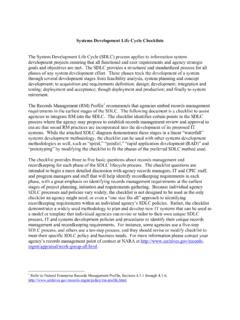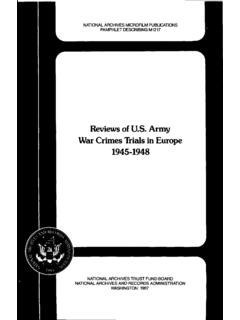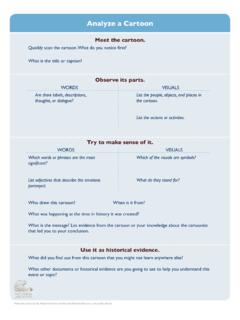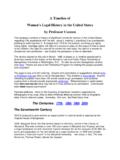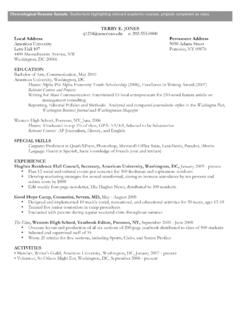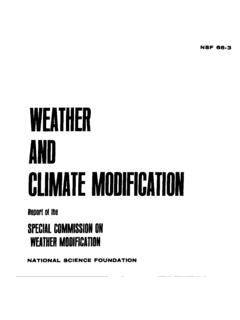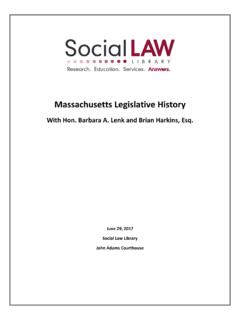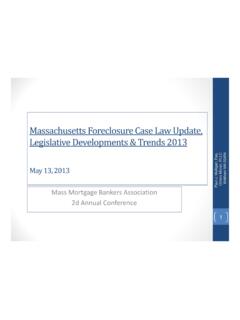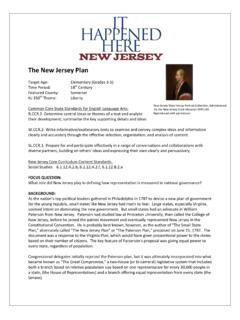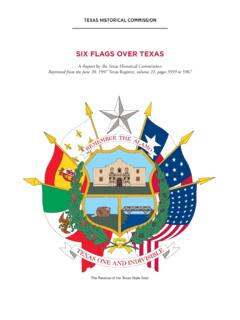Transcription of Understanding Federalism - Archives
1 Understanding Federalism Center for legislative Archives National Archives and Records Administration Worksheet 1 Federalism refers to a system of government divided among local, state, and national responsibilities. It is an important civic concept to understand because people encounter different levels of government from local, to state, to Federal frequently in their everyday experience. Directions: Draw from each definition to fill in the columns to the right. Term Definition Visual Representation Name of Where I Live Federal Government the organization through which political authority is exercised at the national level, the government of the United States State Government the organization through which political authority is exercised at the state level, the government of a specific state Local Government the governing body of a municipality, county, or town Understanding Federalism Center for legislative Archives National Archives and Records Administration Worksheet 2 Directions: 1.
2 Identify the level of government relevant to each example and write the letter of your choice in the appropriate space in the diagram to the left. a. The many small children who live on your neighborhood street love to play outdoors. Unfortunately, the traffic on your street moves too fast, creating a safety hazard. You would like to have a sign installed warning drivers to slow down and watch for children at play. Which level of government would you contact? b. You served in the Army for eight years and are planning to attend college on the Bill (a college scholarship provided by the government to military veterans). Which level of government would you contact to make sure you receive your Bill benefits? c. You have just moved from Casper, Wyoming to Tallahassee, Florida, and you need a driver s license.
3 Which level of government would you contact? 2. Write a one-sentence explanation of Federalism based on these three examples. Local State Federal This diagram shows three levels of government with the citizen represented by a star. Each example on the right presents a situation that might affect: people in one town or county people in one state, such as Florida or Texas people from all 50 states and the territories of the United States Understanding Federalism Center for legislative Archives National Archives and Records Administration 1 Worksheet 3 Federalism has not had one set definition throughout history , because the idea of the appropriate balance of authority among the local, state, and Federal governments has changed over time. Federalism is not specifically defined in the Constitution, but it is suggested in how the national government is described.
4 This worksheet contrasts the first Constitution for the United States, written just after the colonies had declared their independence from Great Britain, with the one adopted by the Founders in 1787. Directions: Read each preamble and answer the questions below. Preamble of Articles of Confederation (1777) To all to whom these Presents shall come, we, the undersigned Delegates of the States affixed to our Names send greeting. Whereas the Delegates of the United States of America in Congress assembled did on the fifteenth day of November in the year of our Lord One Thousand Seven Hundred and Seventy Seven, and in the Second Year of the Independence of America agree to certain articles of Confederation and perpetual Union between the States of New Hampshire, massachusetts -bay, Rhode Island and Providence Plantations, Connecticut, New York, New Jersey, Pennsylvania, Delaware, Maryland, Virginia, North Carolina, South Carolina, and Georgia in the Words following, viz.
5 Articles of Confederation and perpetual Union between the States of New Hampshire, massachusetts -bay, Rhode Island and Providence Plantations, Connecticut, New York, New Jersey, Pennsylvania, Delaware, Maryland, Virginia, North Carolina, South Carolina, and Georgia. (Source: ) 1. Create a diagram illustrating the government described in this preamble. 2. What is the name of the government created in this preamble? 3. Who were the partners creating this union? 4. What relationship of the states to the Federal government is suggested in this preamble? Understanding Federalism Center for legislative Archives National Archives and Records Administration 2 Worksheet 3 Preamble of Constitution of the United States (1787) We the People of the United States, in Order to form a more perfect Union, establish Justice, insure domestic Tranquility, provide for the common defense, promote the general Welfare, and secure the Blessings of Liberty to ourselves and our Posterity, do ordain and establish this Constitution for the United States of America.
6 (Source: ) 5. Create a diagram illustrating the government described in this preamble. 6. What is the name of the government created in this preamble? 7. Who were the partners creating this union? 8. What relationship of the states to the Federal government is suggested in this preamble? Summary Directions: Examine the dates of the two excerpts and write a one-sentence response to each of the following questions: 1. How is the role of the states different in the two preambles? 2. Does the difference in the role of the states suggest a change in the meaning of Federalism ? Explain. Understanding Federalism Center for legislative Archives National Archives and Records Administration 1 Worksheet 4 The list of powers granted to and denied to the Congress in Article I, and the powers reserved by the 10th Amendment of the Constitution serve as an outline of Federalism .
7 Directions: Read the following excerpt from the Constitution. Label each power E if it represents an enumerated power (granted to the Federal government); D if it is a denied power; or R if it is a reserved powers. ARTICLE I, SECTION 8 The Congress shall have Power To lay and collect Taxes, Duties, Imposts and Excises, to pay the Debts and provide for the common Defence and general Welfare of the United States; but all Duties, Imposts and Excises shall be uniform throughout the United States; To borrow Money on the credit of the United States; To regulate Commerce with foreign Nations, and among the several States, and with the Indian Tribes; To establish an uniform Rule of Naturalization, and uniform Laws on the subject of Bankruptcies throughout the United States; To coin Money, regulate the Value thereof, and of foreign Coin, and fix the Standard of Weights and Measures; To provide for the Punishment of counterfeiting the Securities and current Coin of the United States.
8 To establish Post Offices and post Roads; To promote the Progress of Science and useful Arts, by securing for limited Times to Authors and Inventors the exclusive Right to their respective Writings and Discoveries; To constitute Tribunals inferior to the Supreme Court; To define and punish Piracies and Felonies committed on the high Seas, and Offenses against the Law of Nations; To declare War, grant Letters of Marque and Reprisal, and make Rules concerning Captures on Land and Water; Understanding Federalism Center for legislative Archives National Archives and Records Administration 2 Worksheet 4 To raise and support Armies, but no Appropriation of Money to that Use shall be for a longer Term than two Years; To provide and maintain a Navy; To make Rules for the Government and Regulation of the land and naval Forces; To provide for calling forth the Militia to execute the Laws of the Union, suppress Insurrections and repel Invasions; To provide for organizing, arming, and disciplining, the Militia, and for governing such Part of them as may be employed in the Service of the United States, reserving to the States respectively, the Appointment of the Officers, and the Authority of training the Militia according to the discipline prescribed by Congress.
9 To exercise exclusive Legislation in all Cases whatsoever, over such District (not exceeding ten Miles square) as may, by Cession of particular States, and the Acceptance of Congress, become the Seat of the Government of the United States, and to exercise like Authority over all Places purchased by the Consent of the Legislature of the State in which the Same shall be, for the Erection of Forts, Magazines, Arsenals, dock-Yards and other needful Buildings;-And To make all Laws which shall be necessary and proper for carrying into Execution the foregoing Powers, and all other Powers vested by this Constitution in the Government of the United States, or in any Department or Officer thereof. Article I, Section 9. The Migration or Importation of such Persons as any of the States now existing shall think proper to admit, shall not be prohibited by the Congress prior to the Year one thousand eight hundred and eight, but a Tax or duty may be imposed on such Importation, not exceeding ten dollars for each Person.
10 The Privilege of the Writ of Habeas Corpus shall not be suspended, unless when in Cases of Rebellion or Invasion the public Safety may require it. No Bill of Attainder or ex post facto Law shall be passed. No Capitation, or other direct, Tax shall be laid, unless in Proportion to the Census or Enumeration herein before directed to be taken. Understanding Federalism Center for legislative Archives National Archives and Records Administration 3 Worksheet 4 No Tax or Duty shall be laid on Articles exported from any State. No Preference shall be given by any Regulation of Commerce or Revenue to the Ports of one State over those of another: nor shall Vessels bound to, or from, one State, be obliged to enter, clear, or pay Duties in another. No Money shall be drawn from the Treasury, but in Consequence of Appropriations made by Law; and a regular Statement and Account of the Receipts and Expenditures of all public Money shall be published from time to time.


